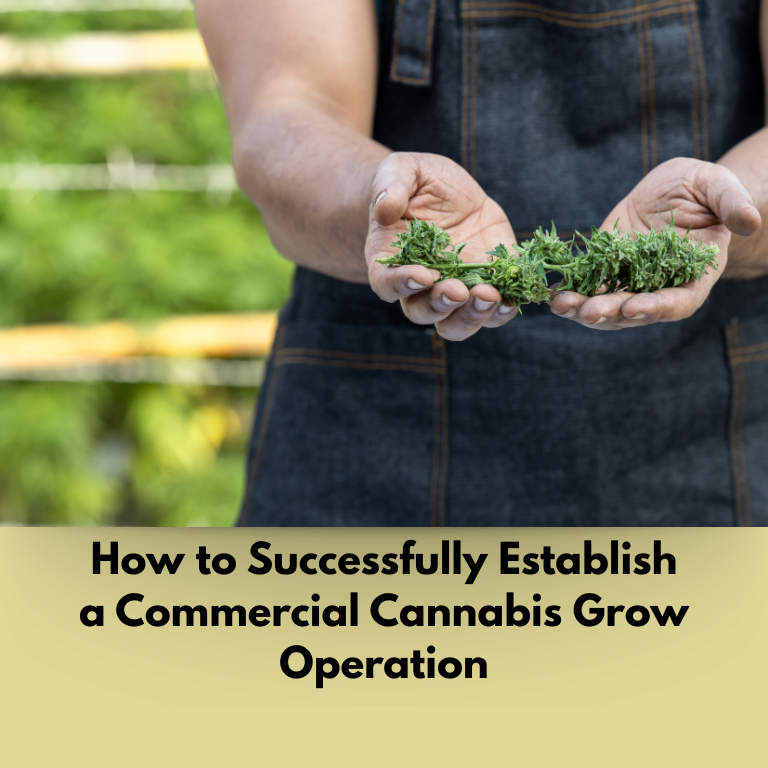Starting a commercial cannabis grow operation requires careful planning, a deep understanding of the legal landscape, and an investment in quality infrastructure. This process is not only about cultivating plants but also about navigating state regulations, securing the right licenses, and ensuring your business is equipped for success. Whether you are an experienced entrepreneur or new to the cannabis industry, understanding the essential steps for setting up your commercial cannabis grow operation is vital for success.
Conduct Thorough Market Research
Before you even start thinking about growing cannabis, it’s crucial to conduct thorough market research. The cannabis market is evolving rapidly, with different regions seeing varying levels of demand and consumer preferences. Understanding your target market is key to crafting a business plan that will be both profitable and sustainable.
Key factors to consider in your market research include:
Consumer Demographics: Who are your potential customers? Are they medical marijuana patients or recreational users? Do they prefer organic or pesticide-free cannabis? These insights will help you tailor your cultivation methods and marketing strategies.
Market Demand: Assess how much demand there is for cannabis in your area, and identify potential competition. A saturated market may require differentiating your product or focusing on niche markets, while a lack of competition could signal an opportunity to establish yourself as a leader.
Pricing Trends: Understand the pricing structure of cannabis products in your area. Competitive pricing is essential for long-term success, but it should not come at the expense of quality.
By gathering information from industry reports, government publications, and other cannabis professionals, you’ll gain a clearer picture of the market landscape. This will be essential when deciding on the scale and nature of your operation.
Secure the Necessary Licenses and Permits
Once you’ve done your research, the next step in setting up a commercial cannabis grow is obtaining the appropriate licenses and permits. Cannabis cultivation is highly regulated, and the requirements vary greatly by state and even by county. In many jurisdictions, a cultivation license is required to legally grow cannabis, and obtaining this license can be a lengthy and detailed process.
Common steps to obtain a cannabis grow license include:
Understanding Local Regulations: Research your state’s specific cannabis cultivation regulations, zoning laws, and environmental rules. In many cases, municipalities have their own requirements that may differ from the state’s guidelines.
Business Plan Submission: A comprehensive business plan that outlines your cultivation processes, security protocols, and how you plan to comply with state regulations is often required. Be prepared to detail everything from your growing methods to your security measures.
Background Checks: Expect owners, operators, and sometimes employees to undergo background checks. A criminal record may prevent you from obtaining a license, depending on the jurisdiction.
Application Fees and Costs: Licensing fees can vary significantly depending on your location. These can range from thousands to hundreds of thousands of dollars, depending on the size and scope of your operation.
Facility Inspections: Your grow facility will likely be inspected by regulators to ensure that it meets all safety, security, and environmental standards.
Choose the Right Location for Your Grow Facility
Location is one of the most important factors to consider when establishing a cannabis grow operation. The environment where you grow your plants can affect everything from yields to operational costs.
Key factors to consider include:
Access to Resources: Water is a critical resource for cannabis cultivation, and your location should provide easy access to reliable water sources. Similarly, having access to electricity and natural sunlight can reduce operating costs.
Proximity to Markets: Choose a location that is accessible to your target market. Being closer to urban centers or major transportation routes can help reduce distribution costs and ensure faster access to consumers.
Zoning and Compliance: Ensure that your facility is located in a zone where cannabis cultivation is allowed. Zoning laws may restrict where cannabis businesses can operate, so understanding these laws is crucial.
Security Concerns: Given the high value of cannabis, security is paramount. Choose a location that is both secure and in compliance with state requirements for surveillance, access control, and perimeter protection.
Invest in High-Quality Equipment and Technology
Once you’ve secured the necessary licenses and chosen the right location, the next step is setting up the actual grow operation. Investing in high-quality equipment and technology is essential for ensuring efficiency, consistency, and scalability in your cannabis production.
Some key elements of your grow operation include:
Grow Rooms: These rooms should be equipped with optimal lighting, humidity control, temperature regulation, and air circulation systems. Depending on your growing methods (indoor, greenhouse, or outdoor), the infrastructure will vary.
Climate Control Systems: Controlling the environment is crucial to maintaining plant health and maximizing yields. Invest in automation systems that can regulate temperature, humidity, and airflow based on real-time data.
Watering Systems: Automated irrigation systems ensure that your cannabis plants receive the right amount of water consistently. Watering systems can also help prevent over-watering and optimize plant growth.
Harvesting and Processing Equipment: You’ll need equipment for harvesting, trimming, drying, and processing cannabis. Investing in efficient machinery will reduce labor costs and speed up production.
Quality Control: Ensure that you have systems in place for monitoring and testing the quality of your cannabis plants, including checking for pests, mold, or other contaminants.
Consider Comprehensive Insurance Coverage
Running a cannabis grow operation comes with a unique set of risks, and protecting your business is essential. As an insurance broker specializing in cannabis businesses, I recommend securing comprehensive insurance coverage to safeguard your investment.
Some key types of insurance for a cannabis grow operation include:
Crop Insurance: Cannabis crops can be vulnerable to natural disasters, pests, and diseases. Crop insurance can provide coverage in the event of crop loss.
General Liability Insurance: This protects your business against claims of bodily injury or property damage that may arise from your operations.
Product Liability Insurance: In the event that your cannabis products cause harm to consumers, product liability insurance will cover legal fees and claims.
Property Insurance: Protect your building, equipment, and inventory against theft, fire, and other unforeseen events.
Stay Compliant with State and Federal Laws
Compliance is crucial in the cannabis industry. Regulations can change frequently, and staying up to date on federal, state, and local laws is essential for avoiding costly mistakes. Hiring a compliance officer or working with a legal advisor can help ensure that your business stays within the legal boundaries at all times.
Starting a commercial cannabis grow operation is no small feat, but with the right planning and resources, it can be an incredibly rewarding venture. By understanding the regulatory landscape, choosing the right location, investing in quality equipment, and securing proper insurance coverage, you can set your business up for long-term success.
As an insurance broker, I specialize in helping cannabis businesses navigate the complexities of this growing industry. If you need assistance with your cannabis grow operation, including insurance solutions tailored to your needs, feel free to reach out to me for guidance.
For more information and personalized advice, contact me at info@cannabisriskmanager.com or visit www.cannabisriskmanager.com.















